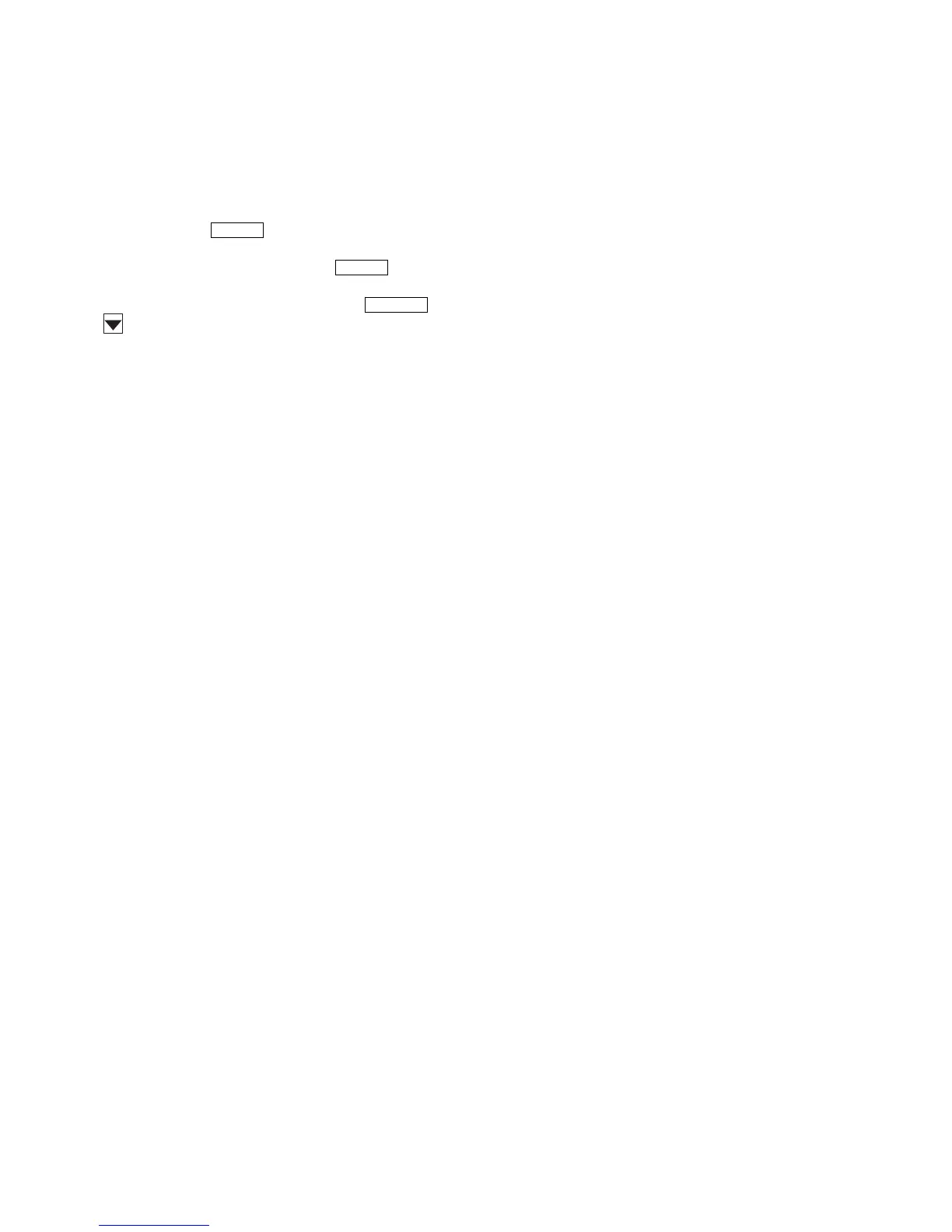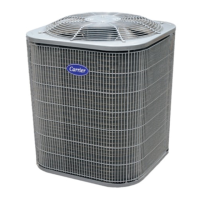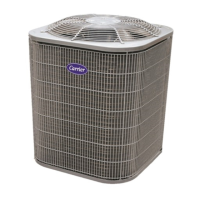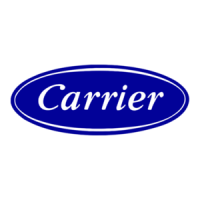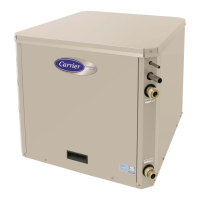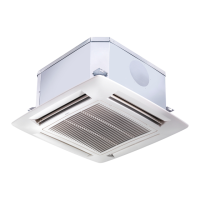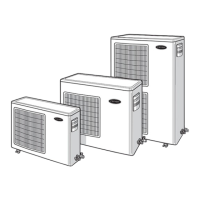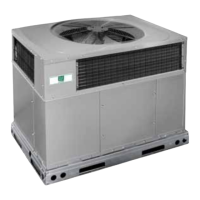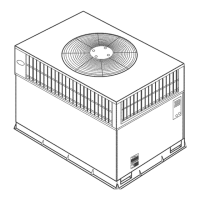28
Service Test — Both main power and control circuit
power must be on.
The Service Test function should be used to verify proper
operation of condenser fan(s), compressors, minimum load
valve solenoid (if installed), liquid line solenoid valve (if
installed), and remote alarm relay. To use the Service Test
mode, the Enable/Off/Remote Contact switch must be in the
OFF position. Use the display keys and Service Test Mode and
Sub-Mode Directory table in Appendix A to enter the mode
and display TEST. Press twice so that OFF flashes.
Enter the password if required. Use either arrow key to change
the TEST value to the ON position and press . Place
the Enable/Off/Remote Contact switch in the ENABLE posi-
tion. The Service Test mode is now enabled. Press
and the down key to enter the OUTS, COMPA or COMPB
sub-mode.
Test the condenser fans, liquid line solenoid and alarm re-
lay by changing the item values from OFF to ON. These dis-
crete outputs are then turned off if there is no keypad activity
for 10 minutes. When testing the digital output the display can
be changed from 1 to 15 by using either the up or down arrow;
the number represents the cycle rate out of a 15 second duty cy-
cle that the output will be energized. If the cycle is set for 7, the
output will be energized 7 seconds out of every 15 seconds.
Test the compressor and minimum load valve solenoid (if in-
stalled) outputs in a similar manner. The minimum load valve
solenoids will be turned off if there is no keypad activity for
10 minutes. Compressors will stay on until they are turned off
by the operator. The Service Test mode will remain enabled for
as long as there is one or more compressors running. All safe-
ties are monitored during this test and they will turn a compres-
sor, circuit or the machine off if required. Any other mode or
sub-mode can be accessed, viewed, or changed during the
TEST mode. The STAT item (Run/Status VIEW) will dis-
play "0" as long as the Service mode is enabled. The TEST
sub-mode value must be changed back to OFF before the unit
can be switched to Enable or Remote contact for normal
operation.
Operating Modes
RAMP LOAD LIMITED (MD05) — Ramp load (pull-
down) limiting is in effect. In this mode, the rate at which sup-
ply fluid temperature is dropped is limited to a predetermined
value to prevent compressor overloading. See Cooling Ramp
Loading (Configuration SLCT CRMP). The pull-down
limit can be modified, if desired, to any rate from 0.2 to 2° F
(0.1 to 1° C) per minute.
TIMED OVERRIDE IN EFFECT (MD06) — Timed over-
ride is in effect. This is a 1 to 4 hour temporary override of the
programmed schedule, forcing unit to Occupied mode. Over-
ride can be implemented with unit under Local (Enable) or
CCN (Carrier Comfort Network
®
) control. Override expires af-
ter each use.
SLOW CHANGE OVERRIDE (MD09) — Slow change
override is in effect. The supply fluid temperature is close to
and moving towards the control point.
MINIMUM OFF TIME ACTIVE (MD10) — Unit is being
held off by Minutes Off Time (Configuration
OPT2 DELY).
TEMPERATURE RESET (MD14) — Temperature reset is
in effect. In this mode, unit is using temperature reset to adjust
supply fluid set point upward and is currently controlling to the
modified set point. The set point can be modified based on re-
turn fluid, outdoor-air-temperature, space temperature, or 4 to
20 mA signal.
DEMAND LIMITED (MD15) — Demand limit is in effect.
This indicates that the capacity of the unit is being limited by
demand limit control option. Because of this limitation, the unit
may not be able to produce the desired supply fluid tempera-
ture. Demand limit can be controlled by switch inputs or a 4 to
20 mA signal.
LOW TEMPERATURE COOLING (MD17) — Unit is in
Cooling mode and the rate of change of the supply fluid is neg-
ative and decreasing faster than -0.5° F per minute. Error be-
tween supply fluid and control point exceeds fixed amount.
Control will automatically unload the unit if necessary.
HIGH TEMPERATURE COOLING (MD18) — Unit is in
Cooling mode and the rate of change of the supply fluid is pos-
itive and increasing. Error between supply fluid and control
point exceeds fixed amount. Control will automatically load
the unit if necessary to better match the increasing load.
TIME GUARD ACTIVE (MDTG) — Compressor time
guard is active, preventing the compressor from starting.
HIGH SCT CIRCUIT A (MD21) — Unit is in a Cooling
mode and the saturated condensing temperature (SCT) is great-
er than the calculated maximum limit. No additional stages of
capacity will be added. Unit capacity may be reduced if SCT
continues to rise to avoid high-pressure switch trips by reduc-
ing condensing temperature.
HIGH SCT CIRCUIT B (MD22) — Unit is in a Cooling
mode and the saturated condensing temperature (SCT) is great-
er than the calculated maximum limit. No additional stages of
capacity will be added. Unit capacity may be reduced if SCT
continues to rise to avoid high-pressure switch trips by reduc-
ing condensing temperature.
MINIMUM COMP ON TIME (MD23) — Cooling load
may be satisfied, however control continues to operate com-
pressor to ensure proper oil return. This may be an indication of
oversized application, low fluid flow rate or low loop volume.
LOW SOUND MODE (MD25) — Not applicable.
Operation of Machine Based on Control
Method —
Machine On/Off control is determined by
the configuration of the control method
(Configuration OPT2 CTRL). With the control method
set to 0, simply switching the Enable/Off/Remote Contact
switch to the Enable or Remote Contact position (external con-
tacts closed) will put the unit in an occupied state. The control
mode (Operating Modes MODE) will be 1 (OFF LOCAL)
when the switch is Off and will be 5 (ON LOCAL) when in the
Enable position or Remote Contact position with external con-
tacts closed.
Two other control methods are available for Machine On/
Off control:
OCCUPANCY SCHEDULE (CTRL=2) — The main base
board will use the operating schedules as defined under the
Time Clock mode in the scrolling marquee display. These
schedules are identical. The schedule number must be set to 1
for local schedule.
The schedule number can be set anywhere from 65 to 99
for operation under a CCN global schedule. The Enable/Off/
Remote Contact must be in the Enable or Remote Contact posi-
tion. The control mode (Operating Modes MODE) will be 1
when the switch is Off. The control mode will be 3 when the
Enable/Off/Remote Contact switch input is On and the time of
day is during an unoccupied period. Similarly, the control
mode will be 7 when the time of day is during an occupied
period.
CCN SCHEDULE (CTRL=3) — An external CCN device
controls the On/Off state of the machine. This CCN device
forces the variable 'CHIL_S_S' between Start/Stop to control
the unit. The control mode (Operating Modes MODE) will
be 1 when the switch is Off. The control mode will be 2 when
the Enable/Off/Remote Contact switch input is On and the

